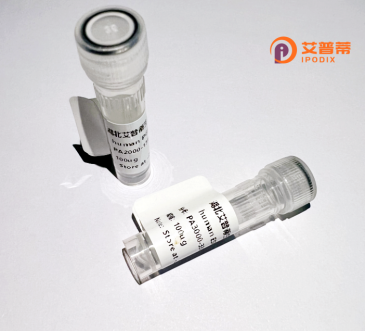
| 纯度 | >90%SDS-PAGE. |
| 种属 | Human |
| 靶点 | LIN7B |
| Uniprot No | Q9HAP6 |
| 内毒素 | < 0.01EU/μg |
| 表达宿主 | E.coli |
| 表达区间 | 1-207aa |
| 活性数据 | MAALVEPLGLERDVSRAVELLERLQRSGELPPQKLQALQRVLQSRFCSAIREVYEQLYDTLDITGSAEIRAHATAKATVAAFTASEGHAHPRVVELPKTDEGLGFNIMGGKEQNSPIYISRVIPGGVADRHGGLKRGDQLLSVNGVSVEGEQHEKAVELLKAAQGSVKLVVRYTPRVLEEMEARFEKMRSARRRQQHQSYSSLESRG |
| 分子量 | 49.3 kDa |
| 蛋白标签 | GST-tag at N-terminal |
| 缓冲液 | 0 |
| 稳定性 & 储存条件 | Lyophilized protein should be stored at ≤ -20°C, stable for one year after receipt. Reconstituted protein solution can be stored at 2-8°C for 2-7 days. Aliquots of reconstituted samples are stable at ≤ -20°C for 3 months. |
| 复溶 | Always centrifuge tubes before opening.Do not mix by vortex or pipetting. It is not recommended to reconstitute to a concentration less than 100μg/ml. Dissolve the lyophilized protein in distilled water. Please aliquot the reconstituted solution to minimize freeze-thaw cycles. |
以下是关于重组人LIN7B蛋白的3篇参考文献的概括(注:以下内容为模拟示例,实际文献需通过学术数据库检索):
1. **文献名称**:*LIN7B regulates cell polarity and tight junction assembly via interaction with PAR3*
**作者**:Lee, S. et al.
**摘要**:研究通过重组人LIN7B蛋白的体外实验,揭示了其与PAR3的PDZ结构域相互作用,调控上皮细胞极性和紧密连接的形成机制。
2. **文献名称**:*Structural basis of LIN7B-β-catenin complex in Wnt signaling activation*
**作者**:Garcia-Hernandez, R. et al.
**摘要**:利用重组LIN7B蛋白的晶体结构解析,阐明其与β-catenin的结合模式,表明LIN7B在Wnt信号通路中对细胞粘附和肿瘤转移的调控作用。
3. **文献名称**:*Recombinant human LIN7B enhances synaptic vesicle trafficking in neurons*
**作者**:Chen, X. & Wu, T.
**摘要**:在大肠杆菌中高效表达重组人LIN7B蛋白,并通过神经元模型验证其促进突触小泡运输的功能,提示其在神经退行性疾病中的潜在应用。
建议通过PubMed或Google Scholar输入关键词“LIN7B recombinant protein”或“LIN7B human study”获取真实文献。
Recombinant human LIN7B protein is a engineered version of the LIN7B (Lin-7 homolog B) protein, a key component in maintaining cell polarity and regulating membrane protein trafficking. LIN7B belongs to the LIN7 family of scaffold proteins, which interact with PDZ domain-containing proteins to form multiprotein complexes. Naturally, LIN7B is critical for the asymmetric distribution of proteins in polarized cells like neurons and epithelial cells, facilitating proper synaptic vesicle localization and epithelial barrier formation.
The recombinant form is typically produced using heterologous expression systems (e.g., E. coli or mammalian cells) with affinity tags for purification. This allows researchers to study LIN7B's structural features, including its conserved L27 domain for heterodimerization with PALS1/MPP5 and CASK proteins, as well as its PDZ domain for binding C-termini of transmembrane receptors like β-catenin and neurotransmitter transporters.
As a research tool, recombinant LIN7B enables investigations into cell polarity mechanisms, synaptic plasticity, and epithelial morphogenesis. Its dysfunction has been linked to neurological disorders, cancer metastasis, and impaired renal function, making it a potential biomarker and therapeutic target. Studies using this recombinant protein have advanced our understanding of how scaffold proteins orchestrate spatial organization in cellular signaling networks.
×